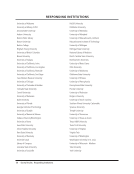SPEC Kit 335: Digital Image Collections and Services · 185
WASHINGTON UNIVERSITY IN ST. LOUIS
Digital Project Support Framework
http://digital.wustl.edu/create/Digital_Project_Framework_Rev_L.doc
This paper describes a framework for handling digital projects at Washington
University. The purpose of this framework is to address some of these issues and discuss
ways in which the University can structure activities to support these projects.
The issues addressed are:
• Long-term maintenance of digital projects
• Role of a central digital library
• Role of a digital asset repository
3 PROJECT SCOPE -WHAT ARE DIGITAL PROJECTS?
For the purposes of this proposal, digital projects are defined as some combination of
scholarly research, research tools, and collections of artifacts that are significantly
computer-aided and usually web-based. For example, an interactive literary scholarly
edition, a web site that presents an organized collection of digital photos and maps on
twelfth century London, or a virtual exploration of the pyramids. What are not addressed
by this proposal are interactive databases where the underlying content is expected to
change rapidly or over long periods. For example, the student information system and
the library catalogue are not covered. The focus, therefore, is on faculty or student-
driven scholarly digital projects where the result is somewhat akin to a book, paper, or
museum exhibit (in its formal intellectual content, not as media).
3.1 THE STRUCTURE OF A DIGITAL PROJECT
The conceptual structure of scholarly digital projects can be broken down into two
general pieces.
1) Content— At the core of a digital project is the content made up of data and
metadata. The data is the scholarly material. It may include images, film clips, paper
or other text blocks, sound clips, maps, etc. Some of the material may be the work of
the scholars involved in the digital project or it may be the work of others. The works
may be digital in origin or digitized copies of non-digital work such as scanned
images. Whereas the data is the primary scholarly information, the metadata describe
information about the data. For example, the data might be a scanned photograph.
The metadata might describe who took the photo, when it was taken, and when it was
digitized. Metadata is the information needed to classify and catalogue the data. In
theory, data with appropriate metadata could be incorporated into other digital
archives.
2) Presentation—Presentation includes both tool development, which allows
researchers to submit queries and derive specific information from a project’s data
set, and static presentation, such as the web page and interface of a project. So, for
example, a literary archive may have a static web page through which users can call
up different editions of an author's work it may also allow users to pose queries, such
as word counts within different documents. The web page is static and the querying
tool is dynamic, but both are presentations of the content.
WASHINGTON UNIVERSITY IN ST. LOUIS
Digital Project Support Framework
http://digital.wustl.edu/create/Digital_Project_Framework_Rev_L.doc
This paper describes a framework for handling digital projects at Washington
University. The purpose of this framework is to address some of these issues and discuss
ways in which the University can structure activities to support these projects.
The issues addressed are:
• Long-term maintenance of digital projects
• Role of a central digital library
• Role of a digital asset repository
3 PROJECT SCOPE -WHAT ARE DIGITAL PROJECTS?
For the purposes of this proposal, digital projects are defined as some combination of
scholarly research, research tools, and collections of artifacts that are significantly
computer-aided and usually web-based. For example, an interactive literary scholarly
edition, a web site that presents an organized collection of digital photos and maps on
twelfth century London, or a virtual exploration of the pyramids. What are not addressed
by this proposal are interactive databases where the underlying content is expected to
change rapidly or over long periods. For example, the student information system and
the library catalogue are not covered. The focus, therefore, is on faculty or student-
driven scholarly digital projects where the result is somewhat akin to a book, paper, or
museum exhibit (in its formal intellectual content, not as media).
3.1 THE STRUCTURE OF A DIGITAL PROJECT
The conceptual structure of scholarly digital projects can be broken down into two
general pieces.
1) Content— At the core of a digital project is the content made up of data and
metadata. The data is the scholarly material. It may include images, film clips, paper
or other text blocks, sound clips, maps, etc. Some of the material may be the work of
the scholars involved in the digital project or it may be the work of others. The works
may be digital in origin or digitized copies of non-digital work such as scanned
images. Whereas the data is the primary scholarly information, the metadata describe
information about the data. For example, the data might be a scanned photograph.
The metadata might describe who took the photo, when it was taken, and when it was
digitized. Metadata is the information needed to classify and catalogue the data. In
theory, data with appropriate metadata could be incorporated into other digital
archives.
2) Presentation—Presentation includes both tool development, which allows
researchers to submit queries and derive specific information from a project’s data
set, and static presentation, such as the web page and interface of a project. So, for
example, a literary archive may have a static web page through which users can call
up different editions of an author's work it may also allow users to pose queries, such
as word counts within different documents. The web page is static and the querying
tool is dynamic, but both are presentations of the content.


































































































































































































